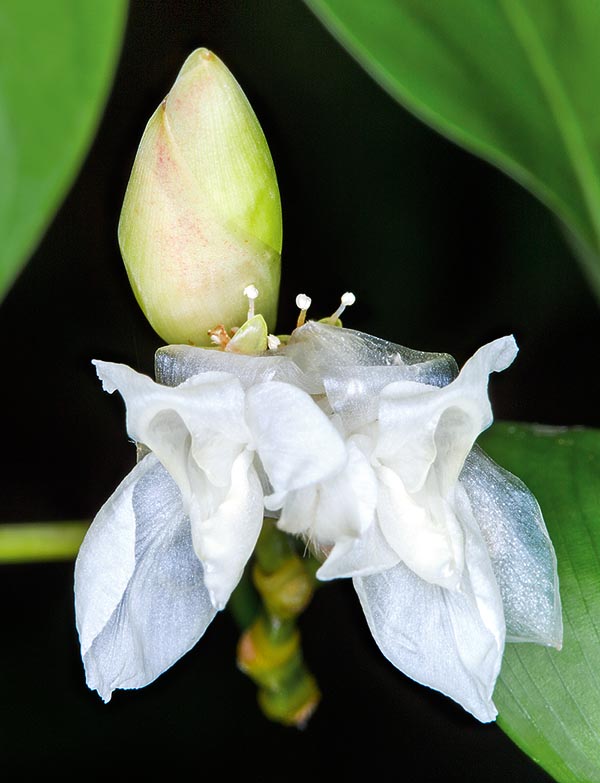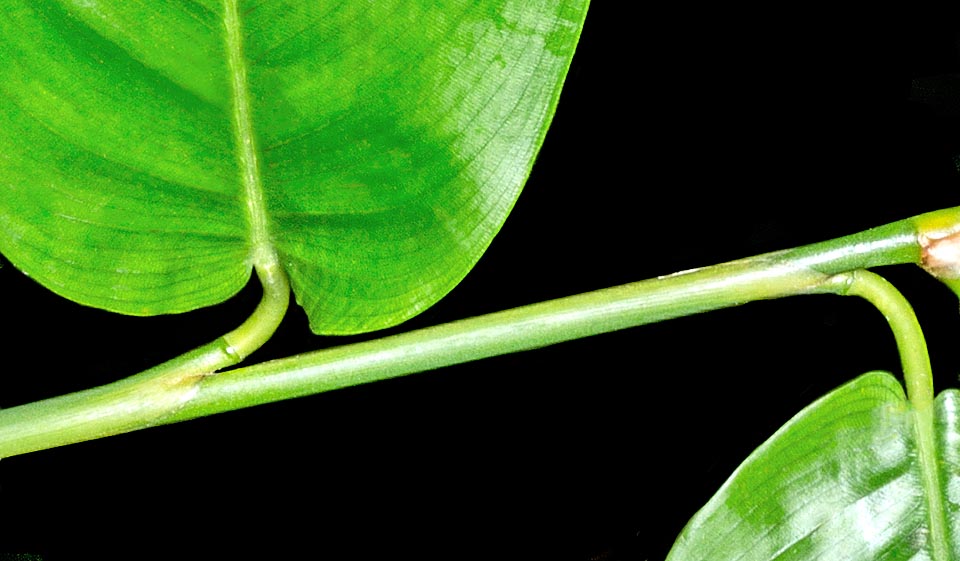Family : Marantaceae

Text © Pietro Puccio

English translation by Mario Beltramini

The Trachyphrynium braunianum is an evergreen rhizomatous specie of tropical Africa that forms ramified subligneous tufts even 4 m tall © Giuseppe Mazza
The species is native to tropical Africa (Benin, Cabinda, Cameroon, Central African Republic, Congo, Democratic Republic of the Congo, Equatorial Guinea, Gabon, Ghana, Guinea, Guinea Gulf Islands, Ivory Coast, Liberia, Nigeria, Sierra Leone, Sudan, Tchad and Uganda) where it grows in the pluvial forests as well as in open spaces, often in swampy areas and along the banks of water streams, from the sea level up to about 1200 m of altitude.
The name of the genus is the combination of the Greek adjective “τραχύς” (trachys) = scabrous, rough and of the genus Phrynium, with reference to the similarity between the two genera and to the fruits thickly covered by sharp protrusions; the species is honoured to the German botanist and collector Johannes M. Braun (1859-93).

Unusual hermaphroditic flowers in pair, white or white-pinkish. Edible fruits © Giuseppe Mazza
Common names: mbonge, ndikasende (Baka); dâànzi (Bafia); dusèseri (Balumbu); dingomboko (Béséki); bîrîn (Gbaya); akukwa (Ibo); akparakitiyai (Izon); botukunkombe (Mbole); mpunge (Mpiemo); ntsèrè (Mpongwé); pete (Ngombe); itsèrè (Ngowé); bili (Ngwaka); ontiéré (Teke); ikokombeibaye (Yaoseko); bolikabwalima (Yasekwe).
The Trachyphrynium braunianum (K. Schum.) Baker (1898) is a perennial, evergreen rhizomatous species, that forms rather messy tufts with subligneous stems, up to more than 4 m tall, ramified above with long and thin branches.
Leaves almost distichous on short petiole and base sheathing the stem, oblong-elliptic lamina with acuminate apex and entire margin, slightly asymmetric with respect to the central rib, 6-25 cm long and 3-8 cm broad, of intense green colour and glossy above.
Terminal inflorescences, simple or at times ramified at the base, about 20 cm long, with pubescent rachis and nodes, spaced of about 6 mm, provided with an oblong-lanceolate bract, deciduous, 2-2,5 cm long, that subtends a couple of white or white-pinkish hermaphroditic flowers, 2,5-3 cm long and of 2 cm of diameter.
Calyx with 3 free sepals, lanceolate with acuminate apex, pubescent, about 1,2 cm long, tubular corolla with 3 linear-lanceolate lobes, stamen and staminodes arranged in two merged verticils at the base of the corolline tube, the outer one with 2 obovate petaloid staminodes, membranaceous, about 2,5 cm long, the inner one with stamen and 2 petaloid staminodes; the ovary is inferior and trilocular.
The fruit is a sub-globose to trilobed capsula, of 1,2-1,5 cm of diameter, thickly covered by short pointed tubercles, orange yellow when ripe, containing 1-3 globose seeds, of about 0,6 cm of diameter, of glossy blackish brown colour, with aril white at the base. It reproduces by seed, but usually and easily by division.
Species diffused in a vast area that covers an imprtant rôle in the rural communities of the origin places, but is practically unknown elsewhere, present only in some Botanical Garden. Its cultivation is limited to the tropical and humid subtropical climates, in full sun or partial shade, and with ample availability of water.

The even 25 cm long leaves, the fruits and roots are used in the traditional medicine. To note the split zone at the base of the petiole. When the leaf is withered it falls in that point. This a quite rare occurrence inside the family of the Marantaceae and is an important element for the identification of some genera and species © G. Mazza
The thin stems are utilized to fabricate baskets, mats, fish traps and other objects of everyday use, braided and covered with mingled clay for the walls of the huts and together with the leaves as cover of makeshift shelters; moreover, the leaves are employed for wrapping food and the fruits are locally consumed roasted. Roots, fruits and leaves are utilized in the traditional medicine for various pathologies
Synonyms: Hybophrynium braunianum K.Schum. (1892); Bamburanta arnoldiana L.Linden (1900).
